#Calendly Integration for data management software
Explore tagged Tumblr posts
Text
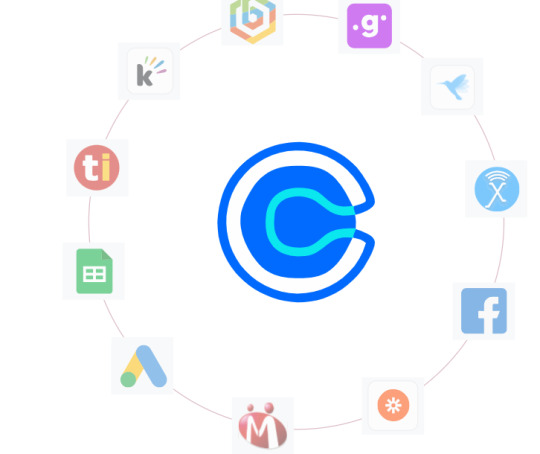
#Calendly Integration for Sales#Calendly Integration for CRM#Calendly Integration for data management software
0 notes
Text
Unlocking Efficiency: Small Business Automation Services in 2025
In today's fast-paced digital economy, small businesses must do more with less. Limited staff, tight budgets, and the ever-growing expectations of customers mean that owners and operators are constantly seeking ways to increase productivity without sacrificing quality. This is where small business automation services come in — offering powerful tools that streamline operations, reduce manual effort, and drive growth.
What Are Small Business Automation Services?
Small business automation services refer to the use of software and digital tools to perform routine tasks without human intervention. These services can handle everything from customer relationship management (CRM) and email marketing to accounting, inventory tracking, scheduling, and more.
Popular examples of automation tools include:
Zapier and Make (formerly Integromat) for workflow automation
QuickBooks for automated accounting and invoicing
HubSpot or Zoho CRM for sales and customer management
Mailchimp or ActiveCampaign for email marketing automation
Calendly for scheduling meetings without back-and-forth emails
Why Automation Matters for Small Businesses
Saves Time and Reduces Errors Automating repetitive tasks frees up employees to focus on higher-value activities like customer service and innovation. It also minimizes human error, particularly in data entry, billing, and order processing.
Increases Productivity With automated systems in place, businesses can scale operations without proportionally increasing workload. One person can manage tasks that previously took an entire team.
Improves Customer Experience Automation enables faster response times, consistent communication, and personalized customer journeys — all critical for retention and loyalty.
Enhances Decision-Making Automated data collection and reporting tools offer insights in real-time, allowing owners to make better-informed decisions with up-to-date information.
Common Areas of Automation for Small Businesses
Marketing Automation: Scheduling social media posts, nurturing leads through email campaigns, and tracking customer behavior.
Sales Automation: Automating follow-ups, managing pipelines, and generating proposals or quotes.
Finance Automation: Handling payroll, invoicing, expense tracking, and tax preparation.
Customer Service Automation: Chatbots, helpdesk ticketing systems, and automated follow-up emails.
Inventory and Order Management: Real-time tracking, automated restocking alerts, and integration with online stores.
Choosing the Right Automation Services
When selecting automation tools, small business owners should consider:
Integration capabilities with existing systems
Scalability for future growth
Ease of use for non-technical staff
Cost-effectiveness relative to the problem being solved
Security and compliance with data protection regulations
It’s often best to start with one area — such as automating email marketing or invoicing — and gradually expand.
Final Thoughts
Small business automation services are not just a luxury — they’re becoming a necessity. By embracing the right tools, even the smallest enterprises can operate with the agility and efficiency of much larger organizations. In 2025 and beyond, the businesses that automate intelligently will be best positioned to thrive in an increasingly competitive landscape.
0 notes
Text
Automating Appointment Reminders to Reduce No-Shows
In various sectors, particularly healthcare, education, and customer service, no-shows can significantly hinder operations. An appointment that is missed not only wastes valuable resources but can also lead to lost revenue. The problem extends beyond finances; frequent no-shows may strain workflows and complicate scheduling. Thus, finding effective strategies to mitigate this issue is essential for businesses looking to optimize their services. The Benefits of Appointment Reminders Automated appointment reminders have emerged as a viable solution for reducing no-show rates. By sending timely notifications, businesses can effectively remind clients of upcoming appointments, minimizing the likelihood of last-minute cancellations or forgotten dates. This proactive approach not only reinforces the importance of the appointment but also enhances customer engagement. Increased Engagement Automated reminders foster better communication between service providers and clients. When reminders are personalized and delivered through preferred channels—such as SMS, email, or phone calls—they make clients feel valued and important. Moreover, these reminders can provide critical information such as appointment details, directions, and pre-appointment instructions, thereby improving the overall customer experience. Improved Time Management For service providers, ensuring that no-shows are minimized through automated reminders enables smoother scheduling. This improved time management allows for better allocation of resources, ensuring that time spent on each appointment is maximized. With fewer gaps in the schedule, businesses not only become more efficient but also increase their potential for revenue generation. Implementing Automated Appointment Reminders To effectively automate appointment reminders, businesses should invest in reliable scheduling software that integrates seamlessly with existing systems. Features such as customizable templates and multi-channel communication options are essential for enhancing user experience. Popular platforms like Calendly, Acuity Scheduling, and Google Calendar offer robust capabilities for automating reminders, making them highly recommended choices. Personalization is Key Personalization plays a pivotal role in the effectiveness of appointment reminders. When reminders are tailored to individual clients, they receive a higher engagement rate. Businesses can include the client’s name, appointment time, and specific details relevant to that appointment, making the reminder feel personal and important. Optimize Timing and Frequency Finding the optimal timing for sending reminders is crucial. Research suggests that sending a reminder 24 to 48 hours before the appointment significantly decreases no-show rates. Additionally, a follow-up reminder a few hours prior can serve as a final nudge, ensuring clients remember their scheduled time. However, businesses should be mindful not to inundate clients with reminders; a thoughtful approach is essential to avoid overwhelming them. Monitoring and Adjusting Strategies To ensure the effectiveness of automated appointment reminders, businesses should continuously monitor engagement metrics. Analyzing data such as open rates, response rates, and no-show statistics can provide insights into how well the reminders are performing. This information allows businesses to optimize their strategies further, improving the overall effectiveness of the reminder system. Adapting to Client Feedback Soliciting feedback from clients about their experience with appointment reminders can yield valuable insights. Businesses can adjust their reminder strategies based on this feedback, allowing them to meet the needs and preferences of their clientele. An adaptable reminder system ensures high engagement rates and builds long-lasting customer relationships. Conclusion Automating appointment reminders stands out as an effective strategy for reducing no-shows and enhancing customer engagement.
By leveraging technology to send timely, personalized reminders, businesses can drastically minimize missed appointments, optimize scheduling, and ultimately boost revenue. Investing in the right scheduling software, focusing on personalization, and continuously monitoring effectiveness are all critical components to successfully implementing this solution. As the landscape of customer service continues to evolve, adopting automated appointment reminders should be an essential consideration for any business striving for efficiency and client satisfaction.
0 notes
Text
The Ultimate Guide to Selecting the Best AI Tools for Productivity
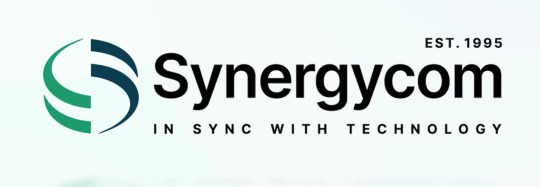
Introduction
In today's fast-paced digital landscape, Artificial Intelligence (AI) has become a game-changer for enhancing productivity. The integration of AI tools into daily tasks can significantly optimize efficiency, allowing individuals and businesses to achieve more in less time. However, with the plethora of AI tools available, selecting the best AI tools for productivity can be daunting. This guide aims to simplify the process and help you make informed decisions that align with your productivity goals.
Understanding AI and Productivity
What is AI?
Artificial Intelligence refers to the simulation of human intelligence processes by machines, especially computer systems. These processes include learning, reasoning, problem-solving, perception, and language understanding. AI tools harness these capabilities to perform tasks more efficiently than traditional software.
How AI Enhances Productivity
AI tools automate repetitive tasks, provide data-driven insights, and facilitate better decision-making, enabling users to focus on high-value activities. They improve accuracy, reduce time consumption, and offer personalized solutions to productivity challenges.
Key Considerations When Selecting AI Tools
Define Your Productivity Goals
Before exploring AI tools, clearly define your productivity goals. Are you looking to automate email management, streamline project workflows, or enhance data analysis capabilities? Understanding your needs will guide you in selecting tools that address specific challenges.
Assess Compatibility
Ensure the AI tools you choose integrate seamlessly with your existing systems and workflows. Consider compatibility with software, devices, and platforms you already use to avoid operational disruptions.
Evaluate User-Friendliness
User-friendliness is crucial when selecting AI tools. Choose tools with intuitive interfaces and easy-to-understand functionalities to ensure smooth adoption and minimize the learning curve.
Consider Cost and ROI
Evaluate the cost of AI tools against the potential return on investment (ROI). Many AI tools offer tiered pricing plans, allowing you to scale as your needs grow. Calculate the potential productivity gains to determine value for money.
Check Customer Support and Security
Reliable customer support can make a significant difference in your experience with AI tools. Ensure the provider offers robust support channels. Additionally, prioritize security, especially if the AI tool will handle sensitive data.
Top AI Tools for Productivity
Task Automation Tools
Zapier: Connects different apps to automate workflows, reducing manual data entry and repetitive tasks.
IFTTT (If This Then That): Automates functions between different services and devices, saving time on routine tasks.
Communication and Collaboration Tools
Slack: An AI-enhanced communication platform that organizes team communications and integrates with various productivity apps.
Microsoft Teams: Facilitates AI-driven collaboration, offering chat, video meetings, and file sharing.
Scheduling and Time Management Tools
Calendly: An AI-driven scheduling tool that automates meeting bookings and sends reminders.
Clockwise: Optimizes calendar events and allocates focus time using AI to enhance productivity.
Data Analysis Tools
Tableau: Utilizes AI to transform data into actionable insights, aiding in decision-making processes.
Google Analytics: Provides AI-powered insights into website performance and user behavior.
Writing and Content Creation Tools
Grammarly: An AI-powered writing assistant that enhances writing quality and accuracy.
Copy.ai: Uses AI to generate creative content and marketing copy, saving time on content creation tasks.
Best Practices for Implementing AI Tools
Start Small and Scale
Begin by integrating a single AI tool to address a specific productivity challenge. As you become familiar with its functionalities and benefits, gradually incorporate additional tools.
Train Your Team
Provide training and resources to ensure your team understands how to effectively use AI tools. This will maximize their potential and drive productivity gains.
Monitor and Evaluate Performance
Regularly monitor the performance of AI tools and evaluate their impact on productivity. Solicit feedback from users to identify areas for improvement and ensure continued success.
Conclusion
Selecting the best AI tools for productivity is a strategic decision that can revolutionize the way you work. By defining your productivity goals, assessing compatibility, and evaluating cost-effectiveness, you can choose tools that deliver maximum value. At Synergycom, we understand the importance of leveraging AI to boost productivity. By integrating the best AI tools for productivity, businesses can achieve greater efficiency and success. Embrace the future of work with Synergycom and unlock new levels of productivity.
Frequently Asked Questions (FAQs)
1. What are the best AI tools for productivity in 2025?
The best AI tools for productivity in 2025 include task automation tools like Zapier, communication platforms like Slack, scheduling tools like Calendly, and data analysis tools like Tableau.
2. How do AI tools enhance productivity?
AI tools enhance productivity by automating repetitive tasks, providing data-driven insights, facilitating communication, and improving decision-making processes.
3. What factors should I consider when selecting AI tools for productivity?
Consider factors such as your productivity goals, compatibility with existing systems, user-friendliness, cost and ROI, customer support, and security.
4. Can AI tools integrate with my current software?
Most AI tools are designed to integrate seamlessly with existing software and platforms. It's essential to check compatibility before implementation.
5. How can AI tools transform workplace productivity?
AI tools transform workplace productivity by reducing manual workloads, optimizing workflows, enhancing collaboration, and providing valuable insights to drive informed decision-making.
0 notes
Text
14 Essential Tools For Designers – Infographic
Every web designer needs the right tools to bring their creative vision to life. In this blog post, we explore 14 essential tools that streamline workflows, enhance productivity, and elevate design quality, whether you’re a graphic, web, or UI/UX designer.

Download Infographic
Design Tools

Designers rely on powerful tools to streamline their creative processes, and three standout options are Figma, Adobe Suite, and Webflow.
Figma is a cloud-based design tool perfect for UI/UX designers, enabling real-time collaboration, prototyping, and seamless design handoff.
Adobe Suite, including Photoshop, Illustrator, and XD, is a powerhouse for graphic, web, and UI/UX design, offering advanced editing, vector creation, and layout tools.
Webflow bridges design and development, allowing designers to create responsive websites visually without coding while offering full control over interactions, animations, and CMS functionality, making it ideal for modern web design projects.
Operations

Efficient project management and organisation are essential for designers, and tools like Notion, Google Calendar, and Google Drive help streamline workflows.
Notion is a versatile workspace that combines note-taking, task management, and database functionality, making it ideal for organising design projects, tracking progress, and collaborating with teams.
Google Calendar ensures designers stay on top of deadlines, meetings, and project timelines with easy scheduling and reminders.
Google Drive offers secure cloud storage, allowing designers to store, share, and collaborate on files in real time, ensuring seamless access to assets from any device, enhancing productivity and teamwork.
Communication

Clear communication is crucial for designers working with teams and clients, and tools like Gmail, Discord, and Zoom make collaboration seamless.
Gmail is a reliable email platform that enables professional communication, file sharing, and integration with other Google Workspace tools, making it essential for client and team interactions.
Discord is a dynamic communication tool with voice channels, chat rooms, and screen-sharing features, perfect for real-time collaboration, brainstorming, and community engagement.
Zoom is a leading video conferencing tool that allows designers to conduct virtual meetings, share screens, and present ideas effectively, ensuring smooth project discussions and feedback sessions.
Automation

Automation tools like Zapier, Calendly, and MailerLite help designers streamline workflows, saving time and effort on repetitive tasks.
Zapier connects different apps and automates tasks, allowing designers to create workflows that sync tools like Gmail, Notion, and Slack without manual input.
Calendly simplifies appointment scheduling by letting clients and teams book meetings based on availability, eliminating back-and-forth emails and ensuring efficient time management.
MailerLite is an intuitive email marketing platform that helps designers automate newsletters, client updates, and promotional campaigns, making it easy to engage with audiences and manage email outreach with minimal effort.
Finances

Managing finances efficiently is crucial for designers, and tools like Rounded and Google Sheets help simplify accounting and budgeting.
Rounded is an intuitive accounting software designed for freelancers and small businesses. It streamlines invoicing, expense tracking, and tax reporting, making financial management stress-free for designers handling multiple clients. With automation features, it reduces admin time and improves cash flow management.
Google Sheets is a versatile tool for tracking expenses, budgeting, and creating financial reports. With cloud-based access and real-time collaboration, designers can maintain financial records, analyse trends, and share data with clients or accountants effortlessly, ensuring organised and transparent financial management.

0 notes
Text
Tools and Resources for Virtual Appointment Setters

Virtual appointment setters are a crucial component in healthcare, providing seamless patient scheduling and enhancing efficiency. For virtual appointment setters to thrive, they need access to specific tools and resources that optimize their workflow, streamline scheduling, and ensure patient satisfaction. In this article, we will explore the essential tools and resources required for virtual appointment setters with a focus on Electronic Medical Records (EMR), time management tools, and telemedicine platforms that make operations smoother for healthcare providers like Vital Virtuals LLC.
Essential Tools for Virtual Appointment Setters
Appointment Scheduling Software
Appointment scheduling is the foundation of any virtual appointment setter’s role. Effective tools ensure seamless patient management and reduce errors in bookings.
Acuity Scheduling: A comprehensive tool that allows for customized appointment settings, automated reminders, and easy rescheduling.
Calendly: A user-friendly solution to manage scheduling based on real-time availability.
SimplePractice: A platform specifically designed for healthcare providers that integrates appointment scheduling with secure patient communication.
Electronic Medical Record (EMR) Systems
EMR systems are indispensable in healthcare, allowing appointment setters to access and update patient records securely. Integrating scheduling with EMR systems ensures the smooth transfer of patient data.
Epic Systems: One of the most widely used EMR systems, it offers seamless integration with appointment scheduling and patient management.
Cerner: A trusted EMR platform that helps appointment setters manage patient records, appointments, and communications in real-time.
AthenaHealth: Known for its flexibility, it allows for easy scheduling and patient data management.

Telemedicine Platforms
In an increasingly virtual healthcare landscape, telemedicine platforms are essential for virtual appointment setters to manage telehealth visits.
Doxy.me: A free, HIPAA-compliant platform designed for telemedicine, perfect for managing virtual consultations.
Zoom for Healthcare: Offers secure, HIPAA-compliant video conferencing, integrating well with scheduling and EMR systems.
VSee: Another reliable telemedicine platform offering features like remote patient monitoring, scheduling, and video consultation.
Communication Tools
Efficient communication with patients and healthcare providers is a key responsibility for virtual appointment setters. The right tools streamline these communications.
RingCentral: A VoIP system that enables virtual staff to manage patient calls effectively.
Gmail/Google Workspace: For managing email communication, document sharing, and syncing calendars for smooth appointment setting.
Slack: For internal communication with healthcare teams and other virtual staff.

Key Resources for Virtual Appointment Setters
HIPAA Compliance Training
HIPAA compliance is non-negotiable for virtual appointment setters handling sensitive patient data. Proper training ensures data security and regulatory compliance.
HIPAA Academy: Provides in-depth training on protecting patient information in healthcare settings.
HIPAA Journal: Offers up-to-date resources on regulations and best practices for patient data protection.
Time Management Resources
Time management is critical for virtual appointment setters. Having the right tools ensures they manage patient appointments efficiently and stay organized.
Time Doctor: An advanced time tracking tool that helps virtual staff monitor time spent on tasks, improving efficiency and productivity.
Toggl: A simple, effective time-tracking tool that enables virtual appointment setters to log the time spent on various tasks.
Google Calendar: A reliable tool for managing daily appointments, tasks, and schedules for effective time management.
Customer Support Tools
Virtual appointment setters often need to troubleshoot patient issues or support them through scheduling processes. Having the right support tools can make this easier.
Zendesk: A ticketing system that helps manage patient inquiries, track issues, and provide timely resolutions.
LiveChat: A real-time chat tool that allows virtual staff to assist patients with appointment setting, inquiries, or scheduling issues instantly.
https://vitalvirtuals.com/wp-content/uploads/sites/2/2024/09/appointment-settler-walk-in.jpg
Benefits of Using the Right Tools and Resources
Enhanced Efficiency
Virtual appointment setters equipped with the right tools can manage appointments faster and more efficiently. Scheduling software and EMR integration reduce manual data entry, freeing up time to focus on patient interaction.
Improved Patient Experience
With the right communication tools and telemedicine platforms, virtual appointment setters can offer patients seamless access to care. Patients can schedule, reschedule, or consult with healthcare providers easily, improving their overall experience.
Cost Savings
For healthcare businesses, using virtual appointment setters with efficient tools can cut overhead costs. Telemedicine and remote working tools reduce the need for physical space, equipment, and in-house staff, offering a cost-effective solution.
Data Security and Compliance
HIPAA-compliant tools and EMR systems ensure the safe handling of sensitive patient data. Proper training and secure platforms protect healthcare providers from potential data breaches or penalties.

Virtual Appointment Setters: Improving Patient Care One Call at a Time
By managing patient appointments remotely, virtual appointment setters are enhancing healthcare practices’ efficiency and patient relationships. Their contributions include:
Seamless Scheduling: They prevent scheduling conflicts, ensuring smoother patient visits.
Regular Patient Communication: By sending reminders and handling follow-ups, virtual setters keep patients informed.
Reduced In-Office Workload: Staff can focus on patient interactions while virtual setters handle scheduling.
Cost-Effective Approach: Virtual appointment setters reduce the need for additional in-office resources.
Flexible Coverage: Virtual support can extend to weekends or evenings, enhancing availability for patients.
With virtual appointment setters, healthcare practices can streamline operations, reduce costs, and improve patient satisfaction.
#PatientCare #VirtualSupport #HealthcareOperations #AppointmentSetting
#medical assistant#virtual assistant#medical virtual assistant#medical scribe#ehrmanagement#virtual appointment setter#appoitment setter#receptionist#virtual appoitments
0 notes
Text
21 Best AI tools and Platforms to grow your contents and podcast
We often feel like we are doing justice with our brand when we are doing it all by ourselves. We feel like if not us, no one would do it more passionately. From my personal experience I can say, This is the BIGGEST MYTH. Successful Entrepreneurs and Creators always outsource those jobs that consume their time, so that they can focus on their real job without any distractions and headaches. Moreover, The latest technologies and such platforms usually do it better. That would have been much worse if you had decided to do it all by yourself because of your lack of expertise in those fields. So I thought a lot, the solution is actually simple.

Just outsource or delegate the tasks to others(as much as possible) and the rest of the tasks to AI. Here are my most favorite tools for all my podcaster buddies out there.
MatchMaker: Connects podcasters with guests for seamless collaboration, helping to promote genuine human connections and expand podcast reach.
Soundorp: Platform that guides you in selecting the best podcasting setup and connects you with freelancers to outsource tedious tasks.
Fiverr: A popular freelance marketplace where you can outsource podcast-related tasks like audio editing, video production, and social media management starting at affordable rates.
Predis AI: AI-powered social media assistant that generates and shares content in your brand’s language, optimizing your online presence with tailored visuals, captions, and more.
Podbean: A cost-effective podcast hosting platform offering seamless publishing, discoverability features, and a one-month free trial for new podcasters.
Jasper: All-in-one AI marketing tool that generates content ideas, scripts, and images, helping to keep your podcast on-brand and relevant with up-to-date data.
Repurpose IO: Automates the content distribution process by allowing you to post on multiple social media platforms with a single click, maximizing visibility.
Krisp AI: AI-based noise-canceling app that removes background noise and echo, ensuring clear and crisp audio quality for your podcasts and remote interviews.
Inflection AI: Conversational AI tool that assists with on-the-go research and copywriting, providing friendly and natural interactions to generate podcast ideas and scripts.
Power Director: AI video editing software that enhances videos with features like speech-to-text transcription, audio restoration, and sky replacement for professional-quality output.
Podsqueeze: AI tool that generates transcripts, show notes, and marketing content for your podcast, optimizing titles and enhancing engagement with minimal effort.
Podder: Analytics tool offering in-depth demographic insights and AI-driven sentiment analysis to help you better understand and grow your podcast audience.
Podcastle: An all-in-one online platform for recording, editing, and enhancing podcasts, with AI tools for converting scripts to lifelike audio.
Adobe Speech Enhancer: AI tool that improves voice recordings to sound professional, allowing podcasters to achieve studio-quality audio without expensive equipment.
Calendly: Scheduling tool that simplifies podcast guest booking by allowing them to choose available times, with additional features for payment collection and blog integration.
Exploding Topics: A trend discovery tool that surfaces rapidly growing topics before they become mainstream, helping podcasters stay ahead of the curve.
Wavve: Transforms podcast audio clips into engaging video content for multimedia promotion, driving traffic to your website and enhancing your marketing efforts.
Starry AI: AI-powered tool that generates unique and eye-catching artwork for podcast cover images, allowing customization across various models and styles.
Riverside: Web-based recording platform trusted by industry leaders like Spotify and Disney, offering secure and high-quality podcast interviews directly from your browser.
Rev: Provides fast and accurate transcription services, including an AI-based option, along with closed captioning and translation, catering to tight deadlines.
Logic Pro: A top-tier audio editing software by Apple that provides tools for professional podcast production, including integrated Dolby Atmos support.
Get the links of these tools and know why these are the top 21 tools for me by reading the Full Blog where I have discussed about these tools in detail and included some bonus tools in the end as well.
1 note
·
View note
Text
Essential Tools for Coaches: Software and Applications
In the ever-evolving realm of coaching, the integration of technology has gained immense significance. Coaches from diverse fields now embrace an assortment of software and applications to optimize their processes, elevate their coaching methodologies, and elevate the performance of their clients. These resources not only simplify coaching procedures but also facilitate a customized and highly impactful coaching experience.
Scheduling software stands as a crucial tool for coaches. Its functionality empowers coaches to efficiently handle appointments, plan sessions, and monitor client progress. Additionally, this software streamlines client session bookings online, eliminating the tediousness of manual scheduling. Notable scheduling software options comprise Calendly, Acuity, and ScheduleOnce. These platforms provide an array of useful features, including automated reminders, time zone conversions, and seamless integration with popular tools such as Google Calendar and Outlook.
Coaches find video conferencing software to be a vital tool. With the growing trend of remote coaching, platforms such as Zoom, Skype, and Google Meet have become essential. They enable coaches to host individual sessions, group coaching, webinars, and virtual workshops. These advanced tools also provide features like screen sharing, recording, and live chat, enhancing the interactivity and engagement of the coaching process.
Coaches require a dependable CRM system, known as Customer Relationship Management, for efficiently managing client information, tracking progress, and maintaining effective communication. Various CRM software options, such as Salesforce, HubSpot, and Zoho CRM, assist coaches in monitoring client goals, progress, and feedback, ultimately ensuring a customized and enhanced coaching experience.
Performance tracking software is indispensable in the field of sports coaching. It aids coaches in monitoring athletes' performance, assessing their strengths and weaknesses, and creating effective training strategies. To illustrate, renowned sports coach Alejandro Arraya Avila leverages performance tracking software to dissect athletes' performance data and craft tailored training regimens.
Furthermore, coaches can reap the advantages of employing project management tools such as Trello, Asana, and Basecamp. These platforms not only aid in task organization and deadline setting but also facilitate seamless collaboration within the coaching team. Additionally, they encompass functionalities like task allocation, progress monitoring, and file sharing, thereby streamlining the management of coaching projects for instructors.
Coaches can leverage various e-learning platforms such as Teachable, Thinkific, and Kajabi to effortlessly build and distribute online courses and training programs. These platforms offer a wide range of features including quizzes, certificates, and insightful student analytics, ensuring a holistic and enriching learning journey for coaches and learners alike.
Conclusively, the utilization of software and applications has completely transformed the coaching industry, bringing about a revolution. These remarkable tools not just simplify the coaching process, but also significantly augment the efficacy of coaching strategies. For this reason, coaches must harness the power of these tools in order to remain competitive and provide an exceptional coaching experience.
0 notes
Text
What software is used to manage coaching classes?
There are several software options that can be used to manage coaching classes. The choice of software depends on the specific needs of your coaching class, but here are some common types of software and their purposes:

Learning Management System (LMS): LMS software is designed to manage and deliver educational content. It can be used to create and organize course materials, track student progress, and facilitate communication between instructors and students. Popular LMS options include Moodle, Canvas, and Blackboard.
Student Information System (SIS): SIS software is used to manage student data, including enrollment, attendance, grades, and personal information. It helps streamline administrative tasks for coaching classes. Common SIS solutions include PowerSchool, Infinite Campus, and Ellucian.
Communication and Collaboration Tools: Effective communication is essential for coaching classes. Tools like Google Workspace (formerly G Suite), Microsoft Teams, or Slack can help instructors and students communicate, collaborate on assignments, and share resources.
Online Scheduling and Booking Software: To manage class schedules and appointments, you can use scheduling software like Calendly or Acuity Scheduling. These tools make it easy for students to book coaching sessions with instructors.
Payment and Billing Software: For managing tuition fees and payments, consider using payment processing software like PayPal, Stripe, or specialized education billing platforms.
Virtual Classroom Software: If your coaching classes are conducted online, virtual classroom software such as Zoom, Microsoft Teams, or Adobe Connect can facilitate live video sessions, screen sharing, and interactive features like chat and polling.
Content Creation Tools: To develop course content, you may need software for creating presentations, documents, and multimedia materials. Microsoft Office, Google Docs, and Adobe Creative Cloud are popular options.
Attendance Tracking Apps: Apps like AttendanceBot or RollCall can help you track and manage student attendance, whether in-person or online.
CRM Software: Customer Relationship Management (CRM) software can be useful for managing student inquiries, enrollment, and maintaining contact records. Popular CRM options include Salesforce and HubSpot.
Survey and Feedback Tools: To collect feedback from students and improve your coaching services, consider using survey tools like SurveyMonkey or Google Forms.
Analytics and Reporting Tools: Tools like Google Analytics or specialized educational analytics platforms can help you analyze student performance and make data-driven decisions.
Project Management Software: For organizing and tracking tasks related to course development and administration, project management tools like Asana, Trello, or Microsoft Project can be beneficial.
It's important to assess your coaching class's specific needs and budget before choosing the right software solutions. Some platforms may offer integrated features, while others may require integration with other tools to meet all your requirements. Additionally, consider factors like scalability, user-friendliness, and customer support when making your selection.
free demo for coaching management software
#coaching management software#coaching software#software#institute management software#institute software#erpsoftware#schoolmanagementsoftware
0 notes
Text
Maximizing Efficiency with ChatBCG's Robust Features and Integrations

Introduction
As an AI expert with years of experience, I have seen the evolution of chatbots and their impact on businesses. Chatbots have become an essential tool for businesses to improve customer service, increase sales, and reduce costs. ChatBCG, a brand that specializes in chatbot development, has been making waves in the industry with its robust features and integrations. In this article, I will explore how ChatBCG can help businesses maximize efficiency and achieve their goals.
The Power of Chatbots in Business
Chatbots have revolutionized the way businesses interact with their customers. They provide 24/7 support, personalized experiences, and instant responses. According to a study by Juniper Research, chatbots are expected to save businesses over $8 billion per year by 2022. ChatBCG's chatbots are designed to provide businesses with the power to automate their customer service, sales, and marketing processes.
ChatBCG's Robust Features
ChatBCG's chatbots come with a range of features that can help businesses improve their efficiency. One of the most notable features is the ability to handle multiple conversations simultaneously. This means that businesses can handle a large volume of customer inquiries without the need for additional staff. ChatBCG's chatbots also come with natural language processing (NLP) capabilities, which allow them to understand and respond to customer inquiries in a human-like manner.
Another feature that sets ChatBCG apart is its integration with popular messaging platforms such as Facebook Messenger, WhatsApp, and WeChat. This means that businesses can reach their customers on the platforms they are already using, without the need for additional software or tools. ChatBCG's chatbots can also be integrated with popular CRM systems such as Salesforce, allowing businesses to manage their customer interactions in one place.
ChatBCG's Integrations
ChatBCG's chatbots can be integrated with a range of third-party tools and services, allowing businesses to automate their workflows and improve their efficiency. For example, ChatBCG's chatbots can be integrated with payment gateways such as PayPal and Stripe, allowing businesses to accept payments directly through the chatbot. ChatBCG's chatbots can also be integrated with scheduling tools such as Calendly, allowing businesses to schedule appointments and meetings directly through the chatbot.
Another integration that sets ChatBCG apart is its integration with AI-powered analytics tools such as Google Analytics and Mixpanel. This allows businesses to track the performance of their chatbots and make data-driven decisions to improve their efficiency. ChatBCG's chatbots can also be integrated with marketing automation tools such as HubSpot, allowing businesses to automate their marketing processes and improve their lead generation and conversion rates.
Conclusion
ChatBCG's chatbots are a powerful tool for businesses looking to improve their efficiency and achieve their goals. With its robust features and integrations, ChatBCG can help businesses automate their customer service, sales, and marketing processes, saving them time and money. As the chatbot industry continues to grow, ChatBCG is poised to be a leader in the space, providing businesses with the tools they need to succeed.
References:
Juniper Research: Chatbots to Deliver $8 Billion Annual Cost Savings by 2022
Article Source: NoneIf you're bored, try learning about it chatbcg.
1 note
·
View note
Text
Challenges While Integrating Calendly with Dynamics 365: A Comprehensive Guide
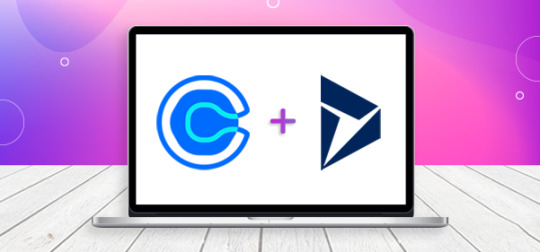
Using a calendar to automate appointment scheduling tasks, activity, and resource management sounds like fun until you realize how and where you will store and fetch the data.
You will need Dynamics 365 CRM data on the calendar to manage projects and resources. If the calendar you use or the subscription plan you opt for does not have the option to integrate the CRM, you won’t be able to use the calendar features at its best.
If we talk about the popular online appointment scheduler Calendly, it does not provide CRM integration for Basic and Essential plans. To avail CRM integration features, you need to opt for a $12/seat/month plan or higher.
These prices might be too much for small business owners or startups who are not ready to pay a big portion every month. Why would anyone pay more when you can get more functionalities and CRM integration at much lesser rates?
To find out how, to stay with us till the very end. This blog will explain how Calendly’s higher subscription plans integrate with the Microsoft Dynamics 365 CRM, the challenges you would face, and how you can overcome them with an alternative tool.
How to integrate Calendly with Microsoft Dynamics 365 CRM

Integrating your Dynamics 365 CRM with Calendly might be a little confusing as you have to do it via a third-party extension. Calendly has collaborated with Zapier to integrate the CRM with the tool.
You will have to create an account with Zapier in order to avail yourself of this functionality.
Challenges While Integrating Calendly With Zapier
Calendly is a standalone app. So, you have to integrate CRM with the help of third-party extensions as It is the only way. You have to choose a premium monthly plan to unlock this feature.
Although Zapier lets you connect the CRM, there are some challenges and limitations. While configuring, you have to set up multiple triggers to fetch the data from the CRM. The entire process is manual and tedious.
Moreover, it lacks customization options. There is limited customization available, so you can only perform actions as per the limited triggers available.
Calendar 365 – A better alternative to Calendly in many ways
For Microsoft Dynamics 365 users, Calendar 365 is a better alternative in many ways. Calendar 365 is a Dynamics plugin that directly integrates with the Dynamics 365 CRM. It is not a standalone app but an extension that will add features to your CRM.
So, you can easily schedule a meeting from within the CRM and manage all the activities of different projects. You can create a calendar with the CRM entities of your choice and save it for future use.
Moreover, Dynamics 365 Calendar is more affordable than Calendly and also comes with a lot more features that not only help with appointment scheduling but also project management.
Calendar 365 is fully customizable as per business requirements or your CRM structure. And that is why it is best for branding purposes.
Where Calendly allows you only to change your logo, Calendar 365 can be redesigned as per your business requirements.
Calendar 365 lets its users customize the meeting forms. This sounds like an impossible deal in Calendly due to the limitations that come while using Zapier.
Conclusion
It is extremely clear from the above discussion that Calendly is not the best choice for Dynamics 365 users. You have to compromise a lot while integrating your Dynamics 365 CRM with the scheduling software.
However, if you choose a Dynamics 365 plugin, it integrates with your CRM, so you don’t need Zapier.
Additionally, Calendar 365 offers customization from forms to customizable UI for branding purposes. All this clearly states that Calendar 365 is way better than Calendly for Microsoft Dynamics 365 CRM users.
All product and company names are trademarks™, registered® or copyright© trademarks of their respective holders. Use of them does not imply any affiliation with or endorsement by them.
This Article is originally published on:
https://www.appjetty.com/blog/dynamics-crm-calendly-integration/
0 notes
Text
Scheduling Software Market is Booming Worldwide | Square, Calendly, HubSpot, SkedPal
The latest study released on the Global Scheduling Software Market by AMA Research evaluates market size, trend, and forecast to 2027. The Scheduling Software market study covers significant research data and proofs to be a handy resource document for managers, analysts, industry experts and other key people to have ready-to-access and self-analyzed study to help understand market trends, growth drivers, opportunities and upcoming challenges and about the competitors.
Key Players in This Report Include: Squarespace (United States), SimplyBook (Notando Iceland Ltd) (Cyprus), HubSpot, Inc. (United States), Setmore (United States), Calendly (United States), Findmyshift B.V. (United Kingdom), Bitrix24 (United States), Appointy Software Inc. (United States), SuperSaaS (Netherlands), Ganttic LLC (Estonia), Square, Inc. (United States), Bookwhen Ltd. (United Kingdom), SkedPal Inc. (MEA), Setster Inc. (United States) Download Sample Report PDF (Including Full TOC, Table & Figures) @ https://www.advancemarketanalytics.com/sample-report/9204-global-scheduling-software-4-market#utm_source=OpenPRVinay
Definition: Organizations today have to deal with tons of meetings, appointments, workforce planning, human resource management, and other complex business processes. It becomes daunting for both individuals and businesses to stick to the schedule and ensure business efficiency. And typical systems are not sufficient to manage messages from e-mails, texts, and other digital channels. In such cases, professionals and organizations need an intelligent system to keep things in the workplace smooth and organized. A good planning tool can help companies increase customer loyalty, optimize resource and project management, and optimize business operations. Scheduling software is a software-as-a-service (SaaS) tool that companies can use to manage appointments, bookings, staff planning, or project management tasks. Planning software automates the planning of events, employees, rooms, and other resources. Companies and professionals are constantly striving to make their work processes more efficient, robust, and reliable. Businesses can also use planning software to minimize paperwork and workflow gaps and encourage their customers to make more money online.
Market Drivers: • Rapid Adoption of Social Media and Growing Numbers of Mobile Users across the World • Increasing Adoption of Cloud-Based Technology in Every Size of Industries in Developed Economies • Demand for Managerial Efficiency across Different Functional Levels • Increasing Use of Workforce Analytics • Increasing Use of Various Scheduling Software in Developed Economies • Growing Need among Enterprises to Centrally Manage and Track Tasks
Market Trend: • Rapid Adoption of Artificial Intelligence and Machine Learning • Adoption of Automated Technology by SMEs and Large Enterprises • Further Innovations Are Developed and Integrated Into the Software • Features Including High Scalability, Ease Of Use, High Customization, and Mobile Support • Technological Up-Gradations in Software Due To High Investments by Key Players
Market Opportunities: • Increasing Demand for Business Automation • Increasing Number of Business Enterprises and Start-Ups • Increasing Demand of Advanced Scheduling Software in Developed Economies • Integration of Scheduling Software with Other Third-Party Tools
The Global Scheduling Software Market segments and Market Data Break Down are illuminated below: by Type (Employee Scheduling Software, Appointment Scheduling Software, Meeting Scheduling Software, Medical Scheduling Software, Others), Application (SMEs, Large Enterprises), Deployment Type (App-Based, Web-Based), Platform (IOS/Mac, Windows, Linux, Android), Subscription Type (Monthly, Quarterly, Annually), Number of Users (2-10, 11-50, 51-200, 201-500, Above 500)
Global Scheduling Software market report highlights information regarding the current and future industry trends, growth patterns, as well as it offers business strategies to help the stakeholders in making sound decisions that may help to ensure the profit trajectory over the forecast years.
Have a query? Market an enquiry before purchase @ https://www.advancemarketanalytics.com/enquiry-before-buy/9204-global-scheduling-software-4-market#utm_source=OpenPRVinay
Geographically, the detailed analysis of consumption, revenue, market share, and growth rate of the following regions: • The Middle East and Africa (South Africa, Saudi Arabia, UAE, Israel, Egypt, etc.) • North America (United States, Mexico & Canada) • South America (Brazil, Venezuela, Argentina, Ecuador, Peru, Colombia, etc.) • Europe (Turkey, Spain, Turkey, Netherlands Denmark, Belgium, Switzerland, Germany, Russia UK, Italy, France, etc.) • Asia-Pacific (Taiwan, Hong Kong, Singapore, Vietnam, China, Malaysia, Japan, Philippines, Korea, Thailand, India, Indonesia, and Australia).
Objectives of the Report • -To carefully analyze and forecast the size of the Scheduling Software market by value and volume. • -To estimate the market shares of major segments of the Scheduling Software • -To showcase the development of the Scheduling Software market in different parts of the world. • -To analyze and study micro-markets in terms of their contributions to the Scheduling Software market, their prospects, and individual growth trends. • -To offer precise and useful details about factors affecting the growth of the Scheduling Software • -To provide a meticulous assessment of crucial business strategies used by leading companies operating in the Scheduling Software market, which include research and development, collaborations, agreements, partnerships, acquisitions, mergers, new developments, and product launches.
Buy Complete Assessment of Scheduling Software market Now @ https://www.advancemarketanalytics.com/buy-now?format=1&report=9204#utm_source=OpenPRVinay
Major highlights from Table of Contents: Scheduling Software Market Study Coverage: • It includes major manufacturers, emerging player's growth story, and major business segments of Scheduling Software market, years considered, and research objectives. Additionally, segmentation on the basis of the type of product, application, and technology. • Scheduling Software Market Executive Summary: It gives a summary of overall studies, growth rate, available market, competitive landscape, market drivers, trends, and issues, and macroscopic indicators. • Scheduling Software Market Production by Region Scheduling Software Market Profile of Manufacturers-players are studied on the basis of SWOT, their products, production, value, financials, and other vital factors. • Key Points Covered in Scheduling Software Market Report: • Scheduling Software Overview, Definition and Classification Market drivers and barriers • Scheduling Software Market Competition by Manufacturers • Impact Analysis of COVID-19 on Scheduling Software Market • Scheduling Software Capacity, Production, Revenue (Value) by Region (2021-2027) • Scheduling Software Supply (Production), Consumption, Export, Import by Region (2021-2027) • Scheduling Software Production, Revenue (Value), Price Trend by Type {Payment Gateway, Merchant Account, Subscription Management,} • Scheduling Software Manufacturers Profiles/Analysis Scheduling Software Manufacturing Cost Analysis, Industrial/Supply Chain Analysis, Sourcing Strategy and Downstream Buyers, Marketing • Strategy by Key Manufacturers/Players, Connected Distributors/Traders Standardization, Regulatory and collaborative initiatives, Industry road map and value chain Market Effect Factors Analysis.
Browse Complete Summary and Table of Content @ https://www.advancemarketanalytics.com/reports/9204-global-scheduling-software-4-market#utm_source=OpenPRVinay
Key questions answered • How feasible is Scheduling Software market for long-term investment? • What are influencing factors driving the demand for Scheduling Software near future? • What is the impact analysis of various factors in the Global Scheduling Software market growth? • What are the recent trends in the regional market and how successful they are?
Thanks for reading this article; you can also get individual chapter wise section or region wise report version like North America, Middle East, Africa, Europe or LATAM, Southeast Asia.
0 notes
Text
Employee Scheduling Software Market - Global Industry Analysis, Size, Share, Growth, Trends, and Forecast 2021 - 2027
Employee Scheduling Software Market 2020-2026
A New Market Study, Titled “Employee Scheduling Software Market Upcoming Trends, Growth Drivers and Challenges” has been featured on fusionmarketresearch.
Description
This global study of the Employee Scheduling Software market offers an overview of the existing market trends, drivers, restrictions, and metrics and also offers a viewpoint for important segments. The report also tracks product and services demand growth forecasts for the market. There is also to the study approach a detailed segmental review. A regional study of the global Employee Scheduling Software industry is also carried out in North America, Latin America, Asia-Pacific, Europe, and the Near East & Africa. The report mentions growth parameters in the regional markets along with major players dominating the regional growth.
Employee scheduling software allows businesses and professionals to manage scheduling appointments and bookings. This type of software is also called appointment booking software and online booking software. Companies use online employee scheduling software to automate scheduling tasks. The system can be used to arrange meetings and appointments. Top features include appointment reminders, employee and customer management, and calendar integration. Advanced solutions include payment processing, revenue processing, and mobile compatibility. You can use this software to update scheduling tasks and improve your companys efficiency.
Request a Sample Report @ https://www.fusionmarketresearch.com/sample_request/(COVID-19-Version)-Global-Employee-Scheduling-Software-Market-Status-(2015-2019)-and-Forecast-(2020-2025)-by-Region,-Product-Type-&-End-Use
The report offers detailed coverage of Employee Scheduling Software industry and main market trends with impact of coronavirus. The market research includes historical and forecast market data, demand, application details, price trends, and company shares of the leading Employee Scheduling Software by geography. The report splits the market size, by volume and value, on the basis of application type and geography.
First, this report covers the present status and the future prospects of the global Employee Scheduling Software market for 2015-2024. And in this report, we analyze global market from 5 geographies: Asia-Pacific[China, Southeast Asia, India, Japan, Korea, Western Asia], Europe[Germany, UK, France, Italy, Russia, Spain, Netherlands, Turkey, Switzerland], North America[United States, Canada, Mexico], Middle East & Africa[GCC, North Africa, South Africa], South America[Brazil, Argentina, Columbia, Chile, Peru]. At the same time, we classify Employee Scheduling Software according to the type, application by geography. More importantly, the report includes major countries market based on the type and application. Finally, the report provides detailed profile and data information analysis of leading Employee Scheduling Software company.
Key Companies Acuity Scheduling Simplybook.me Appointy SetMore MyTime TimeTrade Pulse 24/7 Calendly Bobclass Shortcuts Software Veribook Reservio BookingRun Cirrus Insight CozyCal Square MINDBODY
Market Segment as follows: By Region Asia-Pacific[China, Southeast Asia, India, Japan, Korea, Western Asia] Europe[Germany, UK, France, Italy, Russia, Spain, Netherlands, Turkey, Switzerland] North America[United States, Canada, Mexico] Middle East & Africa[GCC, North Africa, South Africa] South America[Brazil, Argentina, Columbia, Chile, Peru]
Market by Type Cloud, SaaS, Web Mobile – Android Native Mobile – iOS Native Others
Market by Application Small Business Midsize Enterprise Large Enterprise Others
Ask Queries @ https://www.fusionmarketresearch.com/enquiry.php/(COVID-19-Version)-Global-Employee-Scheduling-Software-Market-Status-(2015-2019)-and-Forecast-(2020-2025)-by-Region,-Product-Type-&-End-Use
Table of Contents
Part 1 Market Overview 1.1 Market Definition 1.2 Market Development 1.2.1 Current Situation 1.2.2 Aspects of COVID-19 Impact 1.3 By Type Table Type of Employee Scheduling Software Figure Global Employee Scheduling Software Market Share by Type in 2019 1.4 By Application Table Application of Employee Scheduling Software Figure Global Employee Scheduling Software Market Share by Application in 2019 1.5 By Region Figure Global Employee Scheduling Software Market Share by Region in 2019 Figure Asia Employee Scheduling Software Market Share by Region in 2019
Part 3 Global Market Status and Future Forecast 3.1 Global Market by Region Table Global Employee Scheduling Software Market by Region, 2015-2019 (Million USD) Figure Global Employee Scheduling Software Market Share by Region in 2019 (Million USD) 3.2 Global Market by Company Table Global Employee Scheduling Software Market by Company, 2015-2019 (Million USD) Figure Global Employee Scheduling Software Market Share by Company in 2019 (Million USD) 3.3 Global Market by Type Table Global Employee Scheduling Software Market by Type, 2015-2019 (Million USD) Figure Global Employee Scheduling Software Market Share by Type in 2019 (Million USD) 3.4 Global Market by Application Table Global Employee Scheduling Software Market by Application, 2015-2019 (Million USD) Figure Global Employee Scheduling Software Market Share by Application in 2019 (Million USD) 3.5 Global Market by Forecast Figure Global Employee Scheduling Software Market Forecast, 2020-2025 (Million USD)
…
Part 9 Market Features 9.1 Product Features 9.2 Price Features 9.3 Channel Features 9.4 Purchasing Features Part 10 Investment Opportunity 10.1 Regional Investment Opportunity 10.2 Industry Investment Opportunity
PART 11 Coronavirus Impact 11.1 Impact on Industry Upstream 11.2 Impact on Industry Downstream 11.3 Impact on Industry Channels 11.4 Impact on Industry Competition 11.5 Impact on Industry Obtain Employment Part 12 Conclusion
Continue…
ABOUT US :
Fusion Market Research is one of the largest collections of market research reports from numerous publishers. We have a team of industry specialists providing unbiased insights on reports to best meet the requirements of our clients. We offer a comprehensive collection of competitive market research reports from a number of global leaders across industry segments.
CONTACT US
PH : +(210) 775-2636
0 notes
Text
5 Ways Automation Can Increase Your Work And Sales Productivity

Automation can save you a lot of time if you do repetitive tasks every day. Check out these suggestions for automating your work!
The more work you have to accomplish, the less likely you are to be productive. Perhaps you spend quite a bit of time on tasks like responding to emails or backing up your files.
If you want to maximize your productivity and maximize your time, automate mundane, repetitive tasks.
Here are some ideas to automate your workflow now:
1. Improve email processing speed
In the absence of a system to manage emails effectively, they can be time-consuming and overwhelming. Also, if you want your business to grow, you should promptly reply to emails from potential clients.
Email auto-replies
By automating some processes, you'll spend less time in your inbox. But technology development makes it possible, the Follow-Up option in Outlook allows you to track and respond to emails using the auto-response features.
Alternatively, you can use a cold email and mail merge service like GMass to automate follow-up emails and marketing campaigns.
Email Organization
To manage your email inbox, you can use Gmail filters or Outlook rules.
In addition, you can sort emails into folders based on a specific text or from a particular contact using these in-built features.
Extraction of data
If you sell or market your stuff, you probably spend a lot of time going through contacts in your inbox. You can automate this process by using Mailparser.
2. Use chatbots to boost communication.
In recent years, chatbots have improved customer service and communication. Artificial intelligence or robotic process automation automates chatbots, just like FAQs. It enables them to do many tasks on their own.
Chatbots offer many benefits, such as 24/7 accessibility, multilingual support, instant response times, and customer data. Technologically advances WordPress websites can benefit from chatbots to improve communication and productivity. Chatbots require fine-tuning to reach their maximum potential.
Back up your data
Our computer hard drives increasingly store parts of our lives, such as work files and family photos. The most common causes of hard drive failure are wear, theft, and power surges.
You'll likely forget to do it yourself occasionally. Automate your backups, therefore. Automating backups will ensure data security and uninterrupted work on your computer.
CrashPlan provides data backup to external hard drives, computers on the same network, or our servers. The software offers suggestions for a backup during installation. Furthermore, you can choose what to backup. Schedule your computer to run backups every 15 minutes, every hour, or whenever it is idle.
3. Post on social media
Our lives are increasingly reliant on social media. So, these platforms have become a gold mine for brands, products, and services seeking to promote themselves.
While it is easy to keep up with all of your customers and prospects on social media, it can require a lot of your time. Utilizing tools like Hootsuite and Buffer to automate your social media posts is one method. With these tools, you can do more on social media in less time.
4. Fix meetings
The automation process will put your meeting workflow on autopilot, leaving you free to focus on other tasks. Automating meetings or events using Calendly is easy. You can set different availability times through this link as well as request meetings through it.
Additionally, this tool integrates seamlessly with your calendar. So, once everyone has chosen a time, Calendly will put it on your calendar, and a notification will arrive. You can reschedule if you get busy during that time.
Source:- https://www.itscybertech.com/2021/09/5-ways-automation-can-increase-your.html
#Increase sales productivity#Increase work productivity#technology development#Technologically advances#robotic process automation#automation process
0 notes
Text
Calendly vs Hupport online appointment scheduling Software
Calendly is an online appointment scheduling software. Features like time zone detection, round robin meeting allocation, and calendar integration, you can simplify the scheduling process. It helps save time so that businesses can provide great service and increase sales. In a matter of minutes and without a single line of code, Zapier allows you to connect Calendly and Freshsales.
It eliminates the old-school way of using email and phone tags for scheduling appointments, calls, interviews, demos, and more. It allows hot prospects to connect right away, and ensures staff doesn’t lose them to phone and email tags.

It works simply and beautifully: all you need to do is to set your availability preference, share the link with clients, colleagues, etc. and let them pick a time for the event, which is automatically added to your calendar. It’s more efficient and simplified compared to traditional appointment scheduling solutions, and it makes it easy for users to setup, use, and manage scheduling of appointments and more.
You can come up with custom staff schedules, keeping them organized in a single location for easier management. What’s more, the system automatically provides codes and links for each and every new appointment so that you no longer have to switch in between apps.
You can likewise view who’s manning your office while accepting payments from a single console. The system does not only benefit users, but it also makes life a little easier for your clients as they can use it to book appointments using their laptops, desktop computers or tablets.
Its ability to store customer information and profiles enables it to provide insights into your clientele, allowing you to improve your service.
Calendly has robust payment processing capabilities. Using the platform, you can accept payments via an Authorize.net account sans the required programming as it comes with an API key. If you want, you may also set the system to request customer reviews automatically. Calendly can also send event- and holiday-based messages.
The most direct and hassle-free method for scheduling integration. In addition, all appointments can be synced in between Google Calendar and Calendly. Its integration with MailChimp, meanwhile, automatically syncs all client data to the app.
Hupport online appointment scheduling software
Hupport is a cloud-based appointment scheduling software. It is a software meant to help the users, especially professional organizations and specialists to schedule meetings and appointments. It helps in enhancing the efficiency of scheduling business appointments using the aid of automated software.
There are lots of key features that accompany such scheduling software that can make them a necessity to catch up with the pace in day to day life. Hupport can be integrated with Google, Office 365 and Outlook, and checks all calendars for conflicts to avoid double-booking. It also adds new events to the calendars automatically.
Hupport is simple, easy-to-use, and modern interface ensures a smooth experience and makes the software a pleasure to use. Custom reminders and confirmations can automatically be sent to invitees to ensure maximum retention.

Hupport is also fully optimized for desktops, phones and tablets, ensuring invitees have no compatibility issues while running the software on their devices. The software allows prevention of last-minute meetings, setting buffer times between meetings and secret event types for enhanced privacy and control.
Team’s availability is shown on a single page for maximum convenience. Users can set their capacity and allow multiple invitees to schedule the same slot, which is particularly useful for webinars, tours, workshops and classes. Invitees are also able to quickly add meetings to their own calendars without signing up or registering. Premium subscribers also get fast email support during business hours.
The software differentiates itself from other solutions through its very simple and elegant user interface. It can also be embedded directly into your website, allowing customers to schedule right from there.
Features of Hupport scheduling Software
· Appointment and Schedule Management
· Online Booking
· Point of Sale
· Employee Management
· Calendar integration
· Fully optimized for all devices
· Automatic/custom notifications
· Team scheduling
· User management
· Class Management
· Client Tools
· Marketing
· Reporting
I used various type of appointment scheduling software comparing these Software’s Hupport is very easy to use. For software detail click here.
0 notes
Text
Top 5 Android Apps for Events, Marketing and Sales Teams
If you want to be successful in your business, at hosting events, or as a sales and marketing rep, you need to remain productive. In today’s world, when there are a lot of things that need to get done at the same time, the only way you can be productive is if you can master the art of multitasking.

Thankfully, there are apps for most uses that will simplify your work and make the task simpler. Else, managing leads, writing emails, remembering to keep in touch with customers, attending meetings, monitoring the team’s and your own performance - all at the same time - would have been near impossible.
Read on to know the top 5 Android apps for events, marketing, and sales professionals that will help you to stay at your productive best.
Slack: Helping to Keep in Touch
With over 4 million business professionals using this instant messaging app globally, it is definitely one of the top Android apps that sales and marketing professionals should use.
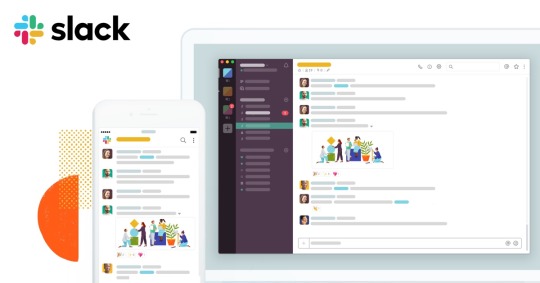
Since it offers instant messaging, it will help you to keep in touch with your team. Some of the advantages of this app are:
Through this virtual chat room, you can create different groups based on different criteria
You can send direct messages to your team
Data is not lost as tracking of all conversation threads is easy
If you are working on something important and you do not want to be disturbed by chat messages you can choose the ‘Do Not Disturb’
You can create profiles for each of your team members with their phone number, Skype ID and others. This will help you to locate them easier
You can get in touch in real-time with audio because this app has a built-in voice calling feature
If you are a part of more than one group and you need to switch between chats, you can do that with ease as well - all you need to do is to use the sidebar
Check out Slack for Android
2. ScanBizCards: Helping to Simplify Contacts and Leads Capture
Imagine attending an event, collecting a large number of business cards, then spending hours manually entering the contact details to create a database of the leads generated. This is how it used to be till some time ago, but times are changing. Now there is an app called ScanBizCards, one of the best card scanner apps, that is being used by more than 2 million users globally, which will help you to create this database in a very short period of time.

After a business conference or a trade show, when you have acquired many business cards, all you need to do is to click a picture of the card. The app then uses OCR technology and exports all the scanned information directly into a CRM or email marketing system. After this you can:
Create personalized folders for each contact
Send introductory emails to all the contacts in your list. You can even add your picture to these emails
You can also find new contacts from email signatures
This app has two versions - a free and a premium version that costs $0.99. You should use the enterprise edition if you use the Salesforce CRM. This allows you to scan an unlimited number of business cards. It has other attractive features also. For example, it will assign you a dedicated admin panel with custom controls for all its associated apps.
Check out ScanBizCards for Android
3. Gmail: Helping to Make Email Sending Easy
While the user base of At one time most used to use Hotmail, Yahoo! Mail, and other email services. However, this has changed in recent times. Nowadays, almost all have a Gmail address.
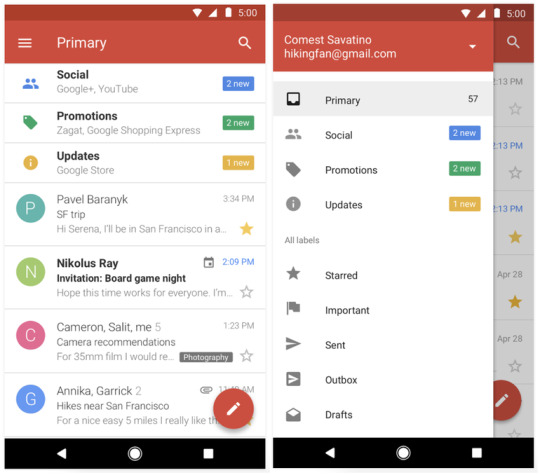
This is because Gmail has powerful features and is user-friendly. Some of its features that makes it the most popular name in emailing are:
An individual can have multiple accounts on the app
The Gmail app integrates with other Google services, like Google Drive, Google Docs, and Google Sheets.
If you receive an invite on the Google Calendar, you can respond to it to from your email
You can sort your emails into different categories like primary, social, promotions, and more
Searching for emails is easy
Emails can be snoozed
If an email gets sent, the act can be undone
Check out Gmail for Android
4. LinkedIn: Helping Professionals to Connect
One of the most popular Android apps to network professionally is LinkedIn. With this app you can:
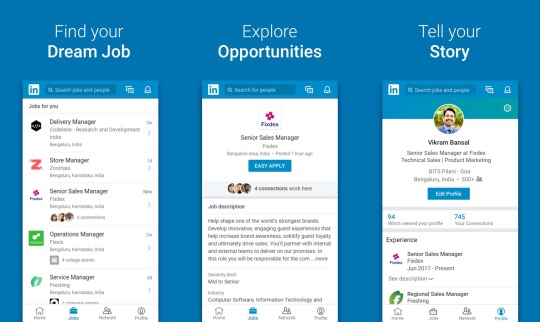
Look for jobs or advertise openings in your organisation
Build on your portfolio by publishing your own articles. As more people view it and comment on it, you will build your image as a thought leader of your industry
Add important people from your industry to your network
Engage with others in your industry. You can do this by commenting on the content that they post
If you see content that is not of interest to you then you can hide it or mark it as spam. LinkedIn will accordingly show you only that content which you like
Join groups that are of interest to you. These groups will help you to learn and also participate in various conversation threads
LinkedIn is also an important app for marketing people as the Campaign Manager can be used to run InMail campaigns. Since these advertisements work on a pay-per-click format, you will need to pay only if someone takes an action on your advertisement.
Check out LinkedIn for Android
5. Calendly: Helping to Remember Important Events
You need to hold a meeting, but you don’t like sending emails. If this is you, then Calendly is the Android app for you. This is a user-friendly, automated scheduling software that will make fixing of meetings an easy task for you.
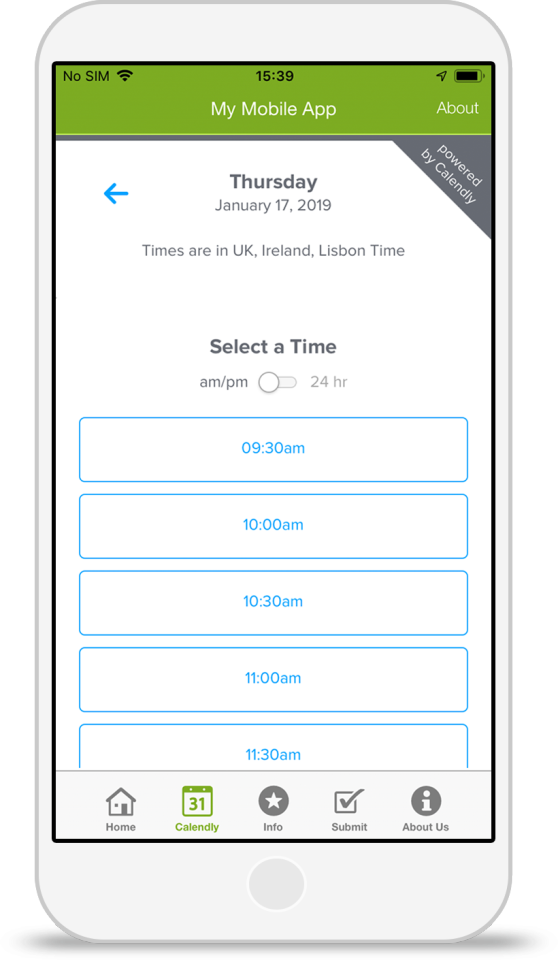
For this you will need to set up options when you are available, inform the others who will attend the meeting about it by sharing the link, and let them decide on the time that best suits them. When they choose a time, it gets added to your calendar. You can use this information to fix one particular time. Using this app is advantageous because you can:
Integrate it with Google, Office 365, and Outlook calendars and also with apps like Salesforce, Stripe, GoToMeeting, and Zapier
Prevent conflicts as it does not allow double booking
Customize reminders that you send to invitees for a meeting
Use it on desktops, phones, and tablets as it has no compatibility issues with them
Hold secret events by using the various privacy controls that it comes with
View the availability of your team on a single page - this will help you when you are fixing a time for your team’s meeting
You can also use this app while hosting online events like a webinar. This is because the app allows the same slot to be chosen by multiple invitees.
Other than these advantages, you can also avail of an email service If you sign up for the premium package.
Check out Calendly for Android
Summing up
There are many Android based apps that are available today. They all look attractive and hence sometimes choosing the right option becomes challenging. However, these five apps will definitely help to ease your task and make you more productive in your work.
0 notes